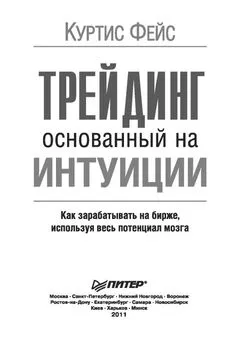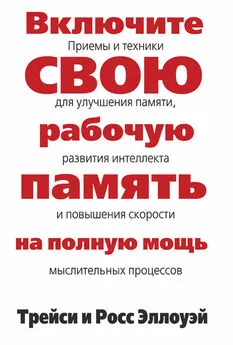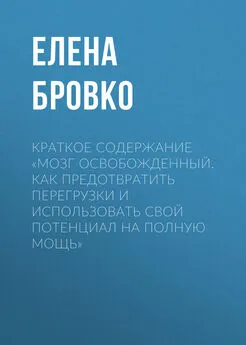Тео Компернолле - Мозг освобожденный. Как предотвратить перегрузки и использовать свой потенциал на полную мощь
- Название:Мозг освобожденный. Как предотвратить перегрузки и использовать свой потенциал на полную мощь
- Автор:
- Жанр:
- Издательство:Array Литагент «Альпина»
- Год:2015
- Город:Москва
- ISBN:978-5-9614-3976-1
- Рейтинг:
- Избранное:Добавить в избранное
-
Отзывы:
-
Ваша оценка:
Тео Компернолле - Мозг освобожденный. Как предотвратить перегрузки и использовать свой потенциал на полную мощь краткое содержание
Мозг освобожденный. Как предотвратить перегрузки и использовать свой потенциал на полную мощь - читать онлайн бесплатно полную версию (весь текст целиком)
Интервал:
Закладка:
IARC Monographs Programme http://www.iarc.fr/en/media-centre/pr/2007/pr180.html
350
Association between habitual sleep duration and blood pressure and clinical implications: A systematic review. Elizabeth Dean and others. Blood Pressure. Feb 2012, Vol. 21, No. 1, pp. 45–57.
351
Short and long sleep duration are associated with prevalent cardiovascular disease in Australian adults. Magee, Christopher A., et al. Journal of sleep research 21.4 (2012): pp. 441–447.
Sleep duration and sleep quality in relation to 12-year cardiovascular disease incidence: the MORGEN study. Hoevenaar-Blom M.P., Spijkerman A.M., Kromhout D., van den Berg J.F., Verschuren W.M. Sleep. 1 Nov 2011; 34(11): pp. 1487–1492.
Immune, inflammatory and cardiovascular consequences of sleep restriction and recovery. Brice Faraut, Karim Zouaoui Boudjeltia, Luc Vanhamme, Myriam Kerkhofs. Sleep Medicine Reviews. Volume 16, Issue 2, April 2012, pp. 137–149.
352
Headache and sleep, Sleep Medicine Reviews, Andrea Alberti, Volume 10, Issue 6, Dec 2006, pp. 431–437.
Melatonin, the pineal gland and their implications for headache disorders. MFP Peres. Cephalalgia, June 2005, vol. 25, no. 6, pp. 403–411.
353
Beauty sleep: experimental study on the perceived health and attractiveness of sleep deprived people John Axelsson. British Medial Journal, Oct 2010; 341: c6614.
354
Chronic Insomnia as a Risk Factor for Developing Anxiety and Depression. Dag Neckelmann, MD, PhD, Amstein Mykletun, PhD, and Alv A. Dahl, MD, PhD. Sleep. 1 July 2007; 30(7): pp. 873–880.
Prevalence, Course, and Comorbidity of Insomnia and Depression in Young Adults. Daniel J. Buysse, MD, JulesAngst, MD, Alex Gamma, PhD, Vladeta Ajdacic, PhD, Dominique Eich, MD, and Wulf Rössler, MA, MD. Sleep. 1 April 2008; 31(4): pp. 473–480.
Insomnia in Young Men and Subsequent Depression. The Johns Hopkins Precursors Study. Patricia P. Chang, Daniel E. Ford, Lucy A. Mead, Lisa Cooper-Patrick1, and Michael J. Klag. Am. J. Epidemiol. (1997) 146 (2): pp. 105–114.
355
Earlier Parental Set Bedtimes as a Protective Factor Against Depression and Suicidal Ideation. James E. Gangwisch. Sleep. Volume 33, Issue 01. 2012.
356
Influences of early shift work on the diurnal cortisol rhythm, mood and sleep: Within-subject variation in male airline pilots, Sophie Bostock, Andrew Steptoe, Psychoneuroendocrinology. Доступно в Интернете 9 Aug 2012.
357
The association of testosterone, sleep, and sexual function in men and women, Monica L. Andersen, Tathiana F. Alvarenga, Renata Mazaro-Costa, Helena C. Hachul, Sergio Tufik, Brain Research, Volume 1416, 6 Oct 2011, pp. 80–104.
Sleep deprivation lowers reactive aggression and testosterone in men, Kimberly A. Cote, Cheryl M. McCormick, Shawn, N. Geniole, Ryan P. Renn, Stacey D. MacAulay, Biological Psychology. Доступно онлайн 6 Oct 2012. http://www.sciencedirect.com/science/article/pii/S0301051112002037
The association of testosterone, sleep, and sexual function in men and women, Monica L. Andersen, Tathiana F. Alvarenga, Renata Mazaro-Costa, Helena C. Hachul, Sergio Tufik, Brain Research, Volume 1416, 6 Oct 2011, pp. 80–104, ISSN 0006–8993, 10.1016/j.brainres.2011.07.060. http://www.sciencedirect.com/science/article/pii/S0006899311014302
358
Daytime sleepiness during transition into daylight saving time in adolescents: Are owls higher at risk? Anne-Marie Schneider, Christoph Randler, Sleep Medicine, Volume 10, Issue 9, Oct 2009, pp. 1047–1050.
359
For an excellent review see: Functional consequences of inadequate sleep in adolescents: A systematic review, Tamar Shochat, Mairav Cohen-Zion, Orna Tzischinsky, Sleep Medicine Reviews. Доступно в Интернете 24 June 2013, ISSN 1087–0792
For an excellent review see: Sleep, cognition, and behavioral problems in schoolage children: a century of research metaanalyzed. R.G. Astill, K.B. Van der Heijden, M.H. Van Ijzendoorn, E.J. Van Someren. Psychological Bulletin, 138 (2012), pp. 1109–1138.
Sleep, cognition, and behavioral problems in school-age children: A century of research meta-analyzed. Astill, R. G., Van der Heijden, K. B., Van IJzendoorn, M. H., & Van Someren, E. J. (2012). Psychological bulletin, 138(6), p. 1109.
In search of lost sleep: secular trends in the sleep time of school-aged children and adolescents. Matricciani, L., Olds, T., & Petkov, J. (2012). Sleep medicine reviews, 16(3), pp. 203–211.
Pathways to adolescent health sleep regulation and behavior. Journal of Adolescent Health, 31 (2002), pp. 175–184.
Sleep and emotions: Bidirectional links and underlying mechanisms, Michal Kahn, Gal Sheppes, Avi Sadeh, International Journal of Psychophysiology, Volume 89, Issue 2, Aug 2013, pp. 218–228.
Adolescent sleep patterns: biological, social, and psychological influences. M.A. Carskadon, C. Acebo. Regulation of sleepiness in adolescents: update, insights, and speculation. Sleep, 25 (2002), pp. 606–614.
The sleepy adolescent: causes and consequences of sleepiness in teens. Moore, M. and Meltzer, L. J. Paediatr. Respir. Rev., 2008, 9: pp. 114–120.
360
The influence of sleep quality, sleep duration and sleepiness on school performance in children and adolescents: A meta-analytic review, Julia F. Dewald, Anne M. Meijer, Frans J. Oort, Gerard A. Kerkhof, Susan M. Bögels, Sleep Medicine Reviews, Volume 14, Issue 3, June 2010, pp. 179–189.
The association between sleep spindles and IQ in healthy school-age children, Reut Gruber, Merrill S. Wise, Sonia Frenette, Bärbel Knäauper, Alice Boom, Laura Fontil, Julie Carrier, International Journal of Psychophysiology, Volume 89, Issue 2, Aug 2013, pp. 229–240.
361
Recent worldwide sleep patterns and problems during adolescence: a review and meta-analysis of age, region, and sleep. M. Gradisar, G. Gardner, H. Dohnt, Sleep Med, 12 (2011), pp. 110–118.
Weekend catch-up sleep is independently associated with suicide attempts and self-injury in Korean adolescents. Kang, S. G., Lee, Y. J., Kim, S. J., Lim, W., Lee, H. J., Park, Y. M., Kim, S. J., Lim (2013). Comprehensive psychiatry. Доступно онлайн 22 Oct 2013.
Functional consequences of inadequate sleep in adolescents: A systematic review, Tamar Shochat, Mairav Cohen-Zion, Orna Tzischinsky, Sleep Medicine Reviews. Доступно в Интернете 24 June 2013, ISSN 1087–0792.
362
Pathways to adolescent health sleep regulation and behavior. Ronald E. Dahl, Daniel S Lewin. Journal of Adolescent Health. Volume 31, Issue 6, Supplement, Dec 2002, pp. 175–184.
Sleep deprivation may be undermining teen health. SIRI CARPENTER. Monitor on psychology. Volume 32, No. 9, Oct 2001. http://www.mjsd.k12.wi.us/mhs/depts/socialstudies/Kelly/documents/sleepteen.pdf
Understanding adolescent’s sleep patterns and school performance: a critical appraisal. Amy R. Wolfson Mary A. Carskadon. Sleep Medicine Reviews. Volume7, Issue 6, 2003, pp. 491–506.
Sleep duration and overweight/obesity in children: Review and implications for pediatric nursing. Liu, J., Zhang, A. and Li, L. (2012), Journal for Specialists in Pediatric Nursing.
363
Reut Gruber, Rachelle Laviolette, Paolo Deluca, Eva Monson, Kim Cornish, Julie Carrier, Short sleep duration is associated with poor performance on IQ measures in healthy school-age children, Sleep Medicine, Volume 11, Issue 3, March 2010, pp. 289–294, ISSN 1389–9457, 10.1016/j.sleep.2009.09.007.
Sadeh, A., Gruber, R. and Raviv, A. (2003), The Effects of Sleep Restriction and Extension on School-Age Children: What a Difference an Hour Makes. Child Development, 74: 444–455.
364
Recent worldwide sleep patterns and problems during adolescence: a review and meta-analysis of age, region, and sleep. M. Gradisar, G. Gardner, H. Dohnt, Sleep Med, 12 (2011), pp. 110–118.
In search of lost sleep: secular trends in the sleep time of school-aged children and adolescents. Matricciani, L., Olds, T., & Petkov, J. (2012). Sleep medicine reviews, 16(3), pp. 203–211.
The Chronic Sleep Reduction Questionnaire (CSRQ): a cross-cultural comparison and validation in Dutch and Australian adolescents. Julia F. Dewald, Michelle A. Short, Michael Gradisar, Frans J. Oort, Anne Marie Meijer. Journal of Sleep Research. 2012. http://dx.doi.org/10.1111/j.1365–2869.2012.00999.x
365
Stress: Friend and Foe. Theo Compernolle. Synergo 1999/Lannoo 2011.
366
Environmental Satisfaction in Open-Plan Environment: 2 Effect of Workstation Size. Charles, K. E.; Veitch, J.A. NRC Institute for Research in Construction; National Research Council Canada 2002. http://www.nrc-cnrc.gcca/obj/irc/doc/pubs/ir/ir845/ir845.pdf
367
Office Type in Relation to Health, Well-Being, and Job Satisfaction Among Employees. Christina Bodin Danielsson and Lennart Bodin, Environment and Behavior 2008; 40: p. 636. Also: http://eab.sagepub.com/content/40/5/636.
368
Should Health Service Managers Embrace Open Plan Work Environments? Vinesh G. Oommen, Mike Knowles, Isabella Zhao. A Review Asia Vol. 3, No. 2, Dec 2008, pp. 37–43.
369
G. Mylonas, J. Carstairs: Review chapter. Open Plan Office Environments: Rhetoric and Reality 2010 http://api.ning.com/files/3ZJ3t4b2xNN 3HrWuGscRE jmNhRwtnZKwtnDJXjXX n00_/OpenPlanOffices.pdf
370
Individual Flexibility in the Workplace A Spatial Perspective. S Varlander. Journal of Applied Behavioral Science, 2012 0021–8863. 48(1): 33. http://jab.sagepub.com/content/48/1/33.full.pdf+html
371
Remaining afloat amid email deluge. Nick Bilton. International New York Times. 20 Jan 2014, р. 14.
372
“Constant, constant, multi-tasking craziness’: managing multi-tasking.e spheres. Victor M. Gonzále, Gloria Mark. Proceedings of the SIGCHI conference on Human factors in computing systems. ACM New York, NY, USA, 2004.
373
“You’ve Got E-Mail!” … Shall I Deal With It Now? Electronic Mail From The Recipientow? Electronic Mail From The Judith Ramsay, Mario Hair. International Journal Of Humanario Hair Interaction, 21(3), pp. 313–332.
374
E-mail as a source and symbol of stress. Barley, S., Myerson, D., and Grodel, S. Organization Science 22, 4 (2011), pp. 887–906.
375
harris interactive Survey, 2010. Quoted in The definitive guide to taming the em@il monster. David Grossman. http://www.yourthoughtpartner.com/Portals/83405/pdf/taming%20the%20e-mail%20monster.pdf?hsCtaTracking=a6b8dec3-ccff-4202-982e-d2363877ef01%7C6bd3eafd-bcb9-42b8-a463-2d1ef2bd913e
376
Charles R. Stoner, Paul Stephens, Matthew K. McGowan, Connectivity and work dominance: Panacea or pariah? Business Horizons, Volume 52, Issue 1, Jan/Feb 2009, pp. 67–78. http://www.sciencedirect.com/science/article/pii/S0007681308001298
377
Google’s Chief Works to Trim a Bloated Ship. CLAIRE CAIN MILLER. The New York Times. 9 Nov 2011.
378
Effects of e-mail addiction and interruptions on employees, Laura Marulanda-Carter, Thomas W. Jackson, (2012) Journal of Systems and Information Technology, Vol. 14 Iss. 1, pp. 82–94.
Читать дальшеИнтервал:
Закладка:










